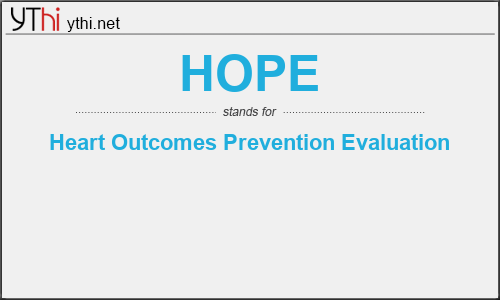What does HOPE mean? What is the full form of HOPE?
The full form of HOPE is Heart Outcomes Prevention Evaluation.
The Heart Outcomes Prevention Evaluation (HOPE) study was designed to test the hypotheses that two preventive intervention strategies, namely angiotensin-converting enzyme (ACE) inhibition or vitamin E, would improve morbidity and mortality in patients at high risk of cardiovascular events compared with placebo. This review addresses the ACE inhibitor (ACE-I) (ramipril) arm of the study, both on the trial population as a whole, and on the large diabetic subgroup. Patients were included in the study who were considered to be at high risk of future fatal or non-fatal cardiovascular events, by virtue of their age (>55 years), existing or previous cardiovascular disease, or diabetes. Diabetics had at least one other risk factor, either known vascular disease or other factors such as cigarette smoking, high cholesterol or hypertension. Ramipril or placebo was added to concomitant medication, which included, in a substantial proportion of patients, antihypertensive drugs (excluding ACE-I), lipid-lowering agents or aspirin. As a result, despite a history of hypertension in nearly 50% of patients, blood pressure (BP) at baseline was normal and the reduction in BP attributable to ramipril modest (a fall of 3-4 mmHg systolic BP and 1-2 mmHg diastolic). The trial was stopped early on the advice of the Data Monitoring Committee because of convincing evidence of the benefit of ramipril treatment on the combined primary endpoint of cardiovascular death, non-fatal myocardial infarct (MI) and non-fatal stroke (14% vs. 17.8% on ramipril and placebo, respectively; relative risk reduction 22%, p<0.001). This comprised a risk reduction of 32% for stroke, 20% for MI, 26% for cardiovascular death and 16% for all-cause mortality, as well as a reduction in the risk of several other endpoints including heart failure and revascularisation procedures. The results among the 3577 diabetic subjects were even more striking, with a reduction of 25% in the combined primary endpoint. This reduction in the combined endpoint and in particular the reduction in MI far exceeded that which would be expected from the modest fall in BP. Furthermore, a multiple regression analysis of the diabetic subgroup showed similar relative risk reductions even after allowing for the effects of the fall in BP. Possible explanations for the non BP-mediated benefits of ramipril include reduction of angiotensin II-induced intimal and vascular smooth muscle proliferation and possible plaque stabilisation. The HOPE study results show that it is both safe and beneficial to lower BP that is already within the ‘normal’ range, particularly in patients with known vascular risk factors. This should greatly extend the use of ACE-I to a wider group of patients – not only those with left ventricular dysfunction, hypertension or diabetic microalbuminuria, but to the sort of high-risk patients who are currently given prophylactic treatment with aspirin.
HOPE
means
Heart Outcomes Prevention Evaluation![]()
Translate Heart Outcomes Prevention Evaluation to other language.


Leave a Reply
You must be logged in to post a comment.